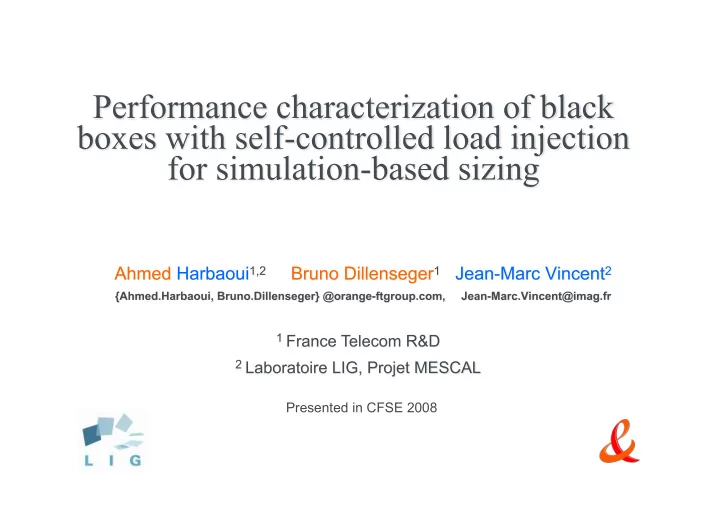

Presented in CFSE 2008
Introduction Sizing and capacity planning are key issues that must be addressed by anyone wanting to ensure a distributed system will sustain an expected workload. Example : Deployment of new service for a million of users. Questions: How much server to use? Middleware ? … to support a given load. In many cases, sizing is done without a defined methodology Problem : Empirical sizing: Loss of a huge amount of money OR Performance problems 2
Problem Position: Sizing Complex/Distributed systems Black boxes 3
Outline 1. Sizing Problem 2. Modeling for performance analysis 1. How to model black boxes 2. Our methodology to model black boxes 3. Saturation and stability 4. Experimental framework 1. CLIF 2. Infrastructure 3. Experience 5. Future work 4
How to model Black boxes 5
Our methodology to model black boxes Our methodology consists in several steps to produce Performance Model: 1. Choosing performance indexes 2. Black boxes decomposition 3. Workload specification 4. Instrumentation 5. Modeling workload 6
Methodology (1/5): Choosing performance indexes Users aspects Resources aspects 7
Methodology (2/5): System decomposition into black boxes Try to divide the system into black boxes network according to: 1. Application Architecture : multi-tiers server, component based application. 2. Locality : distributed application. 3. … Application server HTTP front end Database server 8
Methodology (3/5) :Workload specification According to black boxes decomposition and performance indexes choosing We define the workload to apply. Synthetic workload. Replay a real workload. For good qualification the test load must be as close as possible to the real load. Application server HTTP front end Database server 9
Methodology (4/5) : Instrumentation Instrumentation is define according to black boxes decomposition and performance indexes choosing. Instrumentation deals with monitoring and measuring the use of resources (CPU, memory, …) by placing probes in different parts of the system under test. 10
Methodology (5/5): Modeling Queuing Network 1. Adapted for performance study. 2. Adapted to resource consumption : Server and Queue. 3. Adapted to Black boxes decomposition. Our goal is to model each black box by a queue. 3 type of black boxes (load-dependent black boxes, load- independent black boxes, pure delay black boxes). 11
Modeling : Isolation & characterization of black box In the case of several interacting black boxes: Software-plugs : They replace interactions of the tested black box with other black boxes while conserving a constant value for performance parameters of interest. 12
Saturation and stability 13
Outline 1. Sizing Problem 2. Modeling for performance analysis 1. How to model black boxes 2. Our methodology to model black boxes 3. Saturation and stability 4. Experimental framework 1. CLIF 2. Infrastructure 3. Experience 5. Future work 14
CLIF Load Injection Framework Probes measure usage of load injector 1 arbitrary computing resources probes load injector 2 test supervision arbitrary system under probes test (SUT) Execution control and monitoring of load injector n load injectors and resource probes. Load injectors : • send requests, wait for replies, measure response times • according to a given scenario • for example, emulating the load of a number of real users (through so-called virtual users) 15
Component based infrastructure for autonomic Computing To experiment our methodology, we propose a practical component based infrastructure that fits: 1. Genericity 2. Autonomy Autonomic computing: is the principle of using computing power to get computing systems autonomously manage their complexity. 16
A self-regulated load injection experiment (1) Goal of experiment: find the ESB saturation limit with looped load injection system according to saturation criterion. SUT: E nterprise S ervice B us, a request broker used in Service Oriented Architectures to support mediation features such as accounting, routing, logging, security, management of service level agreement, etc. Black box: ESB. Workload: SOAP requests. Services: Our software plugs, i.e. dummy services that reply to requests with a constant response time, whatever the incoming workload. 17
A self-regulated load injection experiment (2) 4 load injectors A controller distributed on 5 distinct computers (Intel bi-Xeon or AMD bi-Opteron, 2 or 3 GB RAM, Gb/s Ethernet, Linux kernel 2.6.15-1-686-smp). The ESB load probe is hosted on a 6th computer and gets information from the ESB platform's SNMP agent. After 3-4 minutes, A quick and good stabilization of the number of virtual users around 400 and an ESB load around 80%. 18
A self-regulated load injection experiment (2) 4 load injectors A controller distributed on 5 distinct computers (Intel bi-Xeon or AMD bi-Opteron, 2 or 3 GB RAM, Gb/s Ethernet, Linux kernel 2.6.15-1-686-smp). The ESB load probe is hosted on a 6th computer and gets information from the ESB platform's SNMP agent. After 3-4 minutes, A quick and good stabilization of the number of virtual users around 400 and an ESB load around 80%. 19
Conclusion performance Decomposition Workload Instrumentation indexes into BB specification Modeling 20
Future work 21
Thank you for your attention 22
Modeling : 23
Saturation and Stability 24
25
performance Decomposition Workload Instrumentation indexes into BB specification Modeling 26
Recommend
More recommend